
The Civic Museum of Palazzo Mosca (Musei Civici di Palazzo Mosca) is the main civic museum of Pesaro, displaying art and decorative works, located in Piazza Mosca in this town of the region of the Marche, Italy.

The Civic Museum of Palazzo Mosca (Musei Civici di Palazzo Mosca) is the main civic museum of Pesaro, displaying art and decorative works, located in Piazza Mosca in this town of the region of the Marche, Italy.
Since 1936, the main collection has been displayed in the Palazzo Mosca, once belonging to a wealthy merchant family. In the 16th century they built this palace and the rural Villa Caprile outside of town. The palace was refurbished in the 18th century under the patronage of the marquis Francesco. He commissioned the work from Luigi Baldelli, a pupil of Giovanni Andrea Lazzarini.
The Mosca family retained the palace well into the 19th century, until it became property of the commune. The art collections held in the Palazzo Ducale were moved here. The simple facade has a stone portal with the coat of arms of the Mosca family.


The displays occupy five halls in the first floor, and include works from diverse centuries. Among the Renaissance works is the large altarpiece, called the Pesaro Altarpiece or Pala di Pesaro, depicting the Coronation of the Virgin (1475) by Giovanni Bellini. It was originally located in the church of San Francesco, Pesaro.
The second hall contains ceramic works including maiolica from the region. Part of the collection was donated by the marchesa Vittoria Toschi Mosca.
Among the works of the Baroque era are a Magdalen and St Joseph Penitent by Simone Cantarini and a Fall of the Giants by Guido Reni. The collection includes a number of still life paintings by Italian artists. Other artists featured include Christian Berentz and Antonio Gianlisi Junior. Other Baroque painters in the collection include Francesco Albani, Vincenzo Spisanelli, Giovanni Francesco Gessi, Elisabetta Sirani, Carlo Cignani, Giuseppe Maria Crespi, and Aureliano Milani. The museum has a number of paintings emerging from Emilia Romagna, assembled by the Prince Marcantonio Hercolani, including a Sant’Ambrogio by Vitale da Bologna, a Coronation of the Virgin by Simone dei Crocifissi, as well as paintings by Michele di Matteo da Bologna, Mariotto di Nardo, and Giovanni Francesco da Rimini. The portrait of the Procurator of Venice Michele Priuli was painted by Domenico Tintoretto.
The museum also displays items related to the composer Gioachino Rossini, donated by his heir, Hercolani Rossini.
The museum recently acquired 180 works of 20th-century art, including porcelains and paintings, assembled by professor Adalberto Vinciguerra and his wife. Among the masterpieces is a porcelain vase by Gio Ponti, titled La passeggiata archeologica (1925), made by the Manifattura Doccia of Richard Ginori. A number of glass pieces are on display including some from 1921 to 1922 by Vittorio Zecchin completed by Venini e Cappellin; also works by Napoleone Martinuzzi and Carlo Scarpa.
Among the modern collection are paintings by the Futurist Ivo Pannaggi, Pietro Frajacomo, Enrico Prampolini, Silvestro Lega, Giacomo Favretto, and Niccolo Cannicci.
Recently the museum acquired a donation by the jeweler Perlini-Gabucci. [1]

Guido Reni was an Italian painter of the Baroque period, although his works showed a classical manner, similar to Simon Vouet, Nicolas Poussin, and Philippe de Champaigne. He painted primarily religious works, but also mythological and allegorical subjects. Active in Rome, Naples, and his native Bologna, he became the dominant figure in the Bolognese School that emerged under the influence of the Carracci.

Ca' Rezzonico is a palazzo and art museum on the Grand Canal in the Dorsoduro sestiere of Venice, Italy. It is a particularly notable example of the 18th century Venetian baroque and rococo architecture and interior decoration, and displays paintings by the leading Venetian painters of the period, including Francesco Guardi and Giambattista Tiepolo. It is a public museum dedicated to 18th-century Venice and one of the 11 venues managed by the Fondazione Musei Civici di Venezia.

Pesaro is a comune (municipality) in the Italian region of Marche, capital of the province of Pesaro and Urbino, on the Adriatic Sea. According to the 2011 census, its population was 95,011, making it the second most populous city in the Marche, after Ancona. Pesaro was dubbed the "Cycling City" by the Italian environmentalist association Legambiente in recognition of its extensive network of bicycle paths and promotion of cycling. It is also known as "City of Music", for it is the birthplace of the composer Gioachino Rossini. In 2015 the Italian Government applied for Pesaro to be declared a "Creative City" in UNESCO's World Heritage Sites. In 2017 Pesaro received the European City of Sport award together with Aosta, Cagliari and Vicenza.
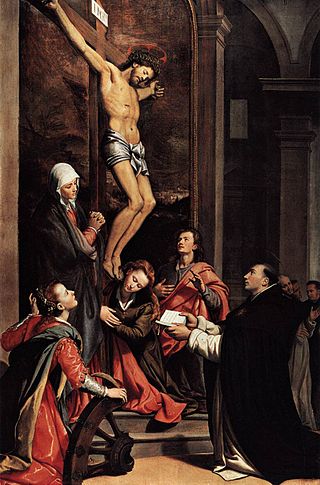
Santi di Tito was one of the most influential and leading Italian painters of the proto-Baroque style – what is sometimes referred to as "Counter-Maniera" or Counter-Mannerism.
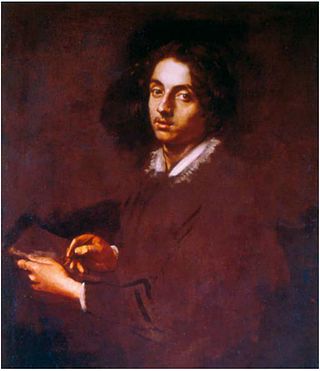
Simone Cantarini or Simone da Pesaro, called il Pesarese was an Italian painter and etcher. He is known mainly for his history paintings and portraits executed in an original style, which united aspects of Bolognese classicism with a bold naturalism.

Giovanni Lanfranco was an Italian painter of the Baroque period.

Museo di Capodimonte is an art museum located in the Palace of Capodimonte, a grand Bourbon palazzo in Naples, Italy designed by Giovanni Antonio Medrano. The museum is the prime repository of Neapolitan painting and decorative art, with several important works from other Italian schools of painting, and some important ancient Roman sculptures. It is one of the largest museums in Italy. The museum was inaugurated in 1957.

Carlo Maratta or Maratti was an Italian painter, active mostly in Rome, and known principally for his classicizing paintings executed in a Late Baroque Classical manner. Although he is part of the classical tradition stemming from Raphael, he was not exempt from the influence of Baroque painting and particularly in his use of colour. His contemporary and friend, Giovanni Bellori, wrote an early biography on Maratta.

Marcantonio Franceschini was an Italian painter of the Baroque period, active mostly in his native Bologna. He was the father and teacher of Giacomo Franceschini.

Palazzo dei Diamanti is a Renaissance palace located on Corso Ercole I d'Este 21 in Ferrara, region of Emilia Romagna, Italy. The main floor of the Palace houses the Pinacoteca Nazionale di Ferrara.

The Palazzo Buonaccorsi is an 18th-century aristocratic palace, now the civic museum of the town, located on Via Don Minzoni 24 in the historic center of Macerata, region of Marche, Italy.

The Museo internazionale e biblioteca della musica is a music museum and music library in the Palazzo Aldini Sanguinetti, in the historic center of Bologna, Italy.

Pietro Fancelli was an Italian painter and set-designer.
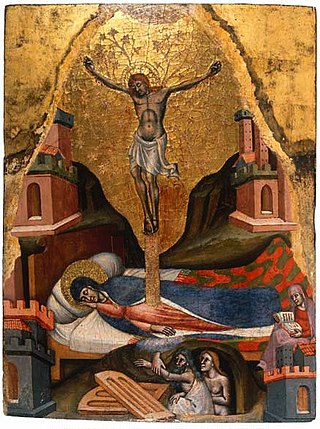
Simone di Filippo Benvenuti, known as Simone dei Crocifissi or Simone da Bologna, was an Italian painter. Born and died in Bologna, he painted many religious panel paintings, and also frescoes in the churches of Santo Stefano and San Michele in Bosco, both at Bologna.

The Palazzo Pepoli Campogrande, also known as Palazzo Pepoli Nuovo, is a Baroque style palace on Via Castiglione 7 in central Bologna, region of Emilia-Romagna, Italy. In 2015, it served as a public art gallery for late-Baroque art. Across the Via, rises the medieval Palazzo Pepoli Vecchio, also once pertaining to the same family, which now serves as a museum of the history of Bologna.
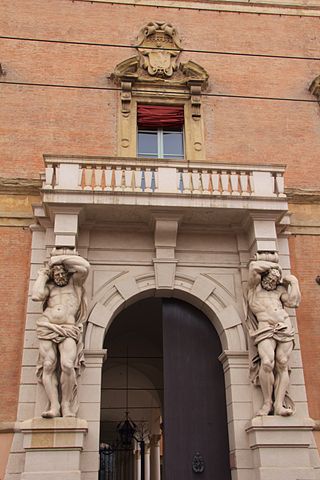
The PalazzoDavìaBargellini is a Baroque style palace located on Strada Maggiore in central Bologna, Italy. It presently hosts the Civic Museum of Industrial art and Davìa Bargellini Gallery, which is an eclectic collection of paintings as well as applied arts and functional ornamentation, described as curiosities of the old Bologna. The diverse applied art collection includes ceramics, liturgical robes, keys, ornamental door knobs, marionettes from street theaters, furniture, iron grille work, elaborately carved wooden frame, and a gilded carriage.

The Galleria Giorgio Franchetti alla Ca' d'Oro is an art museum located in the Ca' d'Oro on the Grand Canal in Venice, Italy.

The Palazzo Loredan Cini is a Gothic-style palace located between the Palazzo Balbi Valier and the Rio San Vio on the Grand Canal, in the sestiere of Dorsoduro, Venice, Italy. The palace was formed from the amalgamation of the former Palazzo Foscari-Loredan with the adjacent Palazzo Grimani. The narrow facade on the Canal has no entrance, but the facade to the north on the Rio, has a single water door, and is connected to the adjacent campo by a bridge. The facade is decorated with two poliforas.
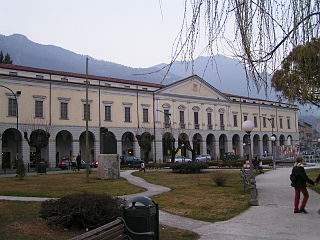
The Accademia Tadini is a museum and art gallery, as well as an academy of both visual arts and music in Lovere, Province of Bergamo, Italy. It is located on Via Tadini #40, facing the shores of Lago d'Iseo.

Simone De Wobreck was a 16th-century Flemish painter, whose known works all come from his long period in Sicily.